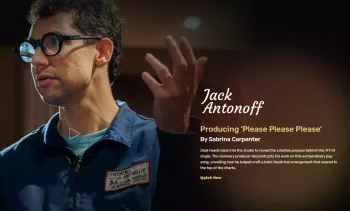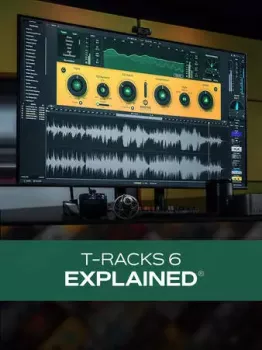Last updated 6/2018
MP4 | Video: h264, 1280x720 | Audio: AAC, 44.1 KHz
Language: English | Size: 8.96 GB | Duration: 2h 0m
英文简介:
Learn to use rhythm, harmony, melody and timbre to effectively and quickly convey different moods in music compositions.
What you'll learn
Use rhythm, harmony and melody to craft emotionally focused music for games, film and TV
Comprehend the elements of music composition that convey emotion effectively
Tell a compelling story in music
Learn from detailed analysis of "urgent", "calm" and "spooky" music examples
Requirements
No specific DAW or audio editor is required - you'll need a DAW, but any one will work. Examples are provided in MIDI and audio as well as Ableton projects/sets.
An interest in composing music for video games, film or TV is recommended.
No prior music theory knowledge is necessary, but the course includes a valuable introduction to scales, numerals, chord tones, color tones and the chromatic scale.
Description
Whether you are a songwriter who wants to get started with writing commercial music or a chronic learner who has always wanted to understand how and why music conveys emotion more effectively than anything else, this course offers insights that you'll find very rewarding.
Learn by watching 3 walkthroughs on emotional music cues conveying "urgent", "calm" and "spooky". Watch and listen as the music speaks for itself AND you get step-by-step explanations about how the music examples work. These lessons are learned from my award-winning songwriting, studio production work and academic study in music and compositional theory.
I've always believed that music is one of the most powerful ways to convey emotion and help a group of people "get on the same page." Rhythm, harmony and melody all play a part, but a good composer can elicit specific emotions quickly - in order to do that, you'll need a strong vocabulary in basic music theory and you'll want to know what your ideas "sound" like before you even play a note. This course combines the art and science of this process. Plus, you'll get a full primer on music theory essentials like
Building major and minor scales by handHow major, minor and half-diminished chords are built from major and minor scalesLearn to compose with chords as numbers, using numerals (how the pros do it)Write elegant, expressive and concise music that gets to the point and delivers the goods
Contents and Overview
After a brief introduction to there course details and your instructor, students will start by listening to 3 examples of music. Next, that music will be analyzed in terms of
RhythmHarmonyCadencesMelodyColor and Timbre
Next, you'll get oriented with a compositional approach to framing your musical ideas as "characters" and "situations". This approach is loosely introduced in the context of theme and variation - a common compositional approach.
Section 3 thoroughly explains how chord numerals work in the context of major and minor scales. This section explains concepts which music students may (or may not) be familiar with such as building scales, triads and 7 chords. This section also explains the appropriate nomenclature (for example a "five chord" or "root, 3rd and 5th"). This section will be a critical value to anyone without music theory training. However, students may skip this section if they already fully understand the rest of the course.
As we continue the course (in section 4) students learn about color and timbre - a crucial pair of elements for any composer to understand when writing emotionally focused music. Students will learn about register, range and timbral character.
After completing your training and background, this course will direct students through a 5 step melody/theme creation process and some clarification on how to create a musical "situation" to match a video game, film or TV scenario. Then, students will walkthrough 3 distinct and complete musical cues - each focused on either an "urgent", "calm" or "spooky" mood.
Each section of the course wraps up with a brief quiz that is designed to help students identify any areas of knowledge that they need to review. This course doesn't bog students down with a comprehensive compositional program. Instead, this course is designed in a workshop style - where students learn the most important take-aways and then are encouraged to try their hand and begin writing music that conveys emotion.
Overview
Section 1: Introduction
Lecture 1 Introduction
Lecture 2 3 Live Examples and Explanations
Lecture 3 Process Overview
Lecture 4 Examining Rhythm and Tempo
Lecture 5 Harmony and Context
Lecture 6 Options for Cadences
Lecture 7 Defining and Exploring Melody
Lecture 8 Color/Timbre Explained
Section 2: Characters and Situations
Lecture 9 Introduction to Themes and Variations
Lecture 10 Example of a Character and Situation
Lecture 11 Using Rhythm Effectively
Lecture 12 Using Harmony in Your Theme.
Lecture 13 Polyrhythm and Time Signatures
Section 3: Music Theory Background
Lecture 14 Building Major Scales
Lecture 15 Relating Major Scale and Major Harmony
Lecture 16 Building Minor Scales
Lecture 17 Relating Minor Scale and Minor Harmony
Section 4: Compositional Considerations
Lecture 18 Detailed Cadence Analysis
Lecture 19 Detailed Melodic Analysis
Lecture 20 Color and Timbre in Your Theme
Lecture 21 Register Explained
Lecture 22 Range Explained
Lecture 23 Timbral Character Explained
Section 5: Hands On Exercises
Lecture 24 Step-By-Step: Creating a Theme
Lecture 25 Step-By-Step: Creating a Variation
Lecture 26 Demo: Conveying an "Urgent" Mood
Lecture 27 Demo: Conveying a "Calm" Mood
Lecture 28 Demo: Conveying a "Spooky" Mood
Section 6: Conclusion
Lecture 29 Bonus Lecture: Wrap Up and Resources
Anyone who wants an introduction to writing music for video games, film or TV,Anyone who is curious about how and why music conveys emotion,Beginners who want to learn basic music theory with examples focused on film/game music composition,This course is for beginners, rather than intermediate or advanced compositional students.
官网: https://www.udemy.com/course/learn-convey-emotion-film-tv-game-music/






![French Connections: From Discotheque to Daft Punk – The Birth of French Touch by Martin James EPUB [EN]](https://audioz.download/uploads/posts/2024-09/thumbs/1727455731_407930774.webp)
评论0